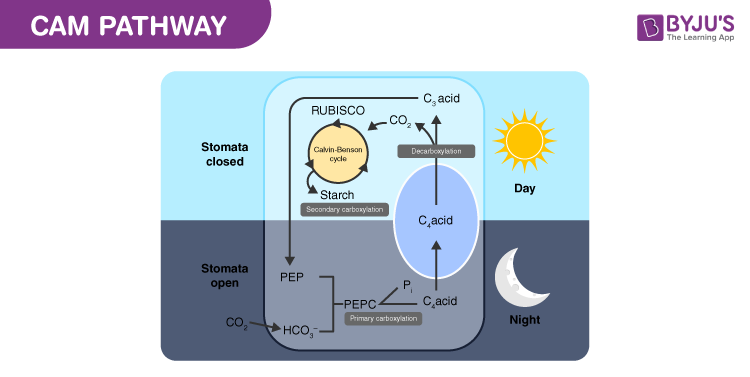Table of Content
Download Complete Chapter Notes of Photosynthesis in Higher Plants
Download Now
CAM Pathway
CAM plants are the plants, which fix carbon dioxide by CAM pathway or Crassulacean acid metabolism. It was first discovered in the plants of the Crassulaceae family. They are present in dry and arid environments. The CAM pathway is adapted to minimise water loss and photorespiration. Examples of CAM plants include cactus, pineapple, etc.

CAM Photosynthesis
CAM pathway is adapted in plants to perform photosynthesis under stress. The CAM pathway reduces photorespiration.
In CAM plants stomata are open at night and they absorb carbon dioxide at night to reduce water loss during the daytime. The process has the following steps:
- The first step in carbon dioxide fixation is the combination of CO2 with PEP (phosphoenolpyruvate) to form 4 carbon oxaloacetate (same as C4 plants) in the chloroplast of mesophyll cells. The reaction is catalysed by PEPcarboxylase. This occurs at night.
- Oxaloacetate is converted to malate and other C4 acids. Malate is stored in vacuoles at night.
- During the daytime, stomata remain closed, so there is no gas exchange. Malate is transported out of the vacuole and CO2 is released by the process of decarboxylation.
- This CO2 finally enters the Calvin cycle and carbon fixation completes. The CO2 which gets accumulated around RuBisCO increases the efficiency of the photosynthesis process and minimizes photorespiration.
CAM Plants Examples
CAM plants are mostly xerophytic. CAM pathway is also present in some aquatic plants such as Hydrilla, Vallisneria, etc. In aquatic plants, the CAM pathway occurs due to scarcity of CO2. Carbon dioxide supply is limited due to slower diffusion in water. Aquatic CAM plants absorb CO2 at night when there is less competition from other photosynthetic plants.
Some of the common examples of CAM plants
Orchids, Cacti, Aloe, Pineapple, Agave, Moringa, Some species of Euphorbia and Bromelioideae, etc.
This was a brief note on CAM Plants. Explore notes on C3, C4 Plants and other important concepts related to NEET, only at BYJU’S.
Frequently Asked Questions
What are some examples of C3, C4 and CAM plants?
Majority of the trees, plants and shrubs are C3 plants. Examples – wheat, rice, oats, soybeans, etc. Plants in the tropical region show C4 pathway to minimise water loss. Examples – bermudagrass, maize, sorghum, etc. CAM plants also use a separate pathway to reduce water loss through photorespiration. Examples – cacti, pineapple.
What are some examples of CAM plants?
Pineapple, orchids, bromeliads, cacti, quillworts, water lobelia, tape grass, water pygmyweed, etc.
Further reading:
- Chromoplast
- Why is Photorespiration bad for C3 plants?
- Difference Between Chlorophyll And Chloroplast
- Difference between C3, C4 and CAM pathway
- Important Notes Of Biology For NEET Morphology Of Flowering Plants
- Flashcards Of Biology For NEET Photosynthesis In Higher Plants
Recommended Video:

Comments